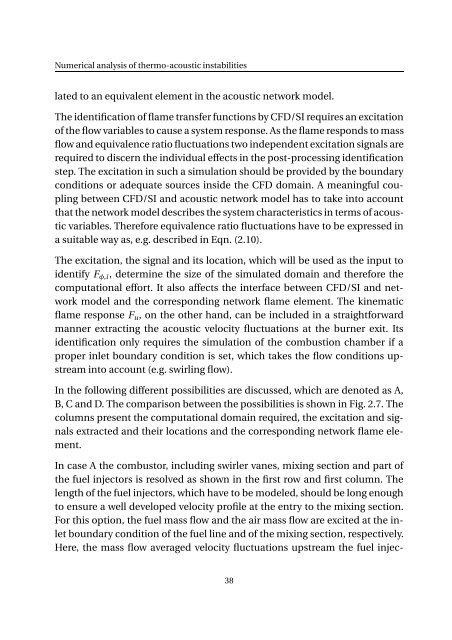Impact of fuel supply impedance and fuel staging on gas turbine ...
Impact of fuel supply impedance and fuel staging on gas turbine ...
Impact of fuel supply impedance and fuel staging on gas turbine ...
You also want an ePaper? Increase the reach of your titles
YUMPU automatically turns print PDFs into web optimized ePapers that Google loves.
Numerical analysis <str<strong>on</strong>g>of</str<strong>on</strong>g> thermo-acoustic instabilities<br />
lated to an equivalent element in the acoustic network model.<br />
The identificati<strong>on</strong> <str<strong>on</strong>g>of</str<strong>on</strong>g> flame transfer functi<strong>on</strong>s by CFD/SI requires an excitati<strong>on</strong><br />
<str<strong>on</strong>g>of</str<strong>on</strong>g> the flow variables to cause a system resp<strong>on</strong>se. As the flame resp<strong>on</strong>ds to mass<br />
flow <str<strong>on</strong>g>and</str<strong>on</strong>g> equivalence ratio fluctuati<strong>on</strong>s two independent excitati<strong>on</strong> signals are<br />
required to discern the individual effects in the post-processing identificati<strong>on</strong><br />
step. The excitati<strong>on</strong> in such a simulati<strong>on</strong> should be provided by the boundary<br />
c<strong>on</strong>diti<strong>on</strong>s or adequate sources inside the CFD domain. A meaningful coupling<br />
between CFD/SI <str<strong>on</strong>g>and</str<strong>on</strong>g> acoustic network model has to take into account<br />
that the network model describes the system characteristics in terms <str<strong>on</strong>g>of</str<strong>on</strong>g> acoustic<br />
variables. Therefore equivalence ratio fluctuati<strong>on</strong>s have to be expressed in<br />
a suitable way as, e.g. described in Eqn. (2.10).<br />
The excitati<strong>on</strong>, the signal <str<strong>on</strong>g>and</str<strong>on</strong>g> its locati<strong>on</strong>, which will be used as the input to<br />
identify F φ,i , determine the size <str<strong>on</strong>g>of</str<strong>on</strong>g> the simulated domain <str<strong>on</strong>g>and</str<strong>on</strong>g> therefore the<br />
computati<strong>on</strong>al effort. It also affects the interface between CFD/SI <str<strong>on</strong>g>and</str<strong>on</strong>g> network<br />
model <str<strong>on</strong>g>and</str<strong>on</strong>g> the corresp<strong>on</strong>ding network flame element. The kinematic<br />
flame resp<strong>on</strong>se F u , <strong>on</strong> the other h<str<strong>on</strong>g>and</str<strong>on</strong>g>, can be included in a straightforward<br />
manner extracting the acoustic velocity fluctuati<strong>on</strong>s at the burner exit. Its<br />
identificati<strong>on</strong> <strong>on</strong>ly requires the simulati<strong>on</strong> <str<strong>on</strong>g>of</str<strong>on</strong>g> the combusti<strong>on</strong> chamber if a<br />
proper inlet boundary c<strong>on</strong>diti<strong>on</strong> is set, which takes the flow c<strong>on</strong>diti<strong>on</strong>s upstream<br />
into account (e.g. swirling flow).<br />
In the following different possibilities are discussed, which are denoted as A,<br />
B, C <str<strong>on</strong>g>and</str<strong>on</strong>g> D. The comparis<strong>on</strong> between the possibilities is shown in Fig. 2.7. The<br />
columns present the computati<strong>on</strong>al domain required, the excitati<strong>on</strong> <str<strong>on</strong>g>and</str<strong>on</strong>g> signals<br />
extracted <str<strong>on</strong>g>and</str<strong>on</strong>g> their locati<strong>on</strong>s <str<strong>on</strong>g>and</str<strong>on</strong>g> the corresp<strong>on</strong>ding network flame element.<br />
In case A the combustor, including swirler vanes, mixing secti<strong>on</strong> <str<strong>on</strong>g>and</str<strong>on</strong>g> part <str<strong>on</strong>g>of</str<strong>on</strong>g><br />
the <str<strong>on</strong>g>fuel</str<strong>on</strong>g> injectors is resolved as shown in the first row <str<strong>on</strong>g>and</str<strong>on</strong>g> first column. The<br />
length <str<strong>on</strong>g>of</str<strong>on</strong>g> the <str<strong>on</strong>g>fuel</str<strong>on</strong>g> injectors, which have to be modeled, should be l<strong>on</strong>g enough<br />
to ensure a well developed velocity pr<str<strong>on</strong>g>of</str<strong>on</strong>g>ile at the entry to the mixing secti<strong>on</strong>.<br />
For this opti<strong>on</strong>, the <str<strong>on</strong>g>fuel</str<strong>on</strong>g> mass flow <str<strong>on</strong>g>and</str<strong>on</strong>g> the air mass flow are excited at the inlet<br />
boundary c<strong>on</strong>diti<strong>on</strong> <str<strong>on</strong>g>of</str<strong>on</strong>g> the <str<strong>on</strong>g>fuel</str<strong>on</strong>g> line <str<strong>on</strong>g>and</str<strong>on</strong>g> <str<strong>on</strong>g>of</str<strong>on</strong>g> the mixing secti<strong>on</strong>, respectively.<br />
Here, the mass flow averaged velocity fluctuati<strong>on</strong>s upstream the <str<strong>on</strong>g>fuel</str<strong>on</strong>g> injec-<br />
38
















